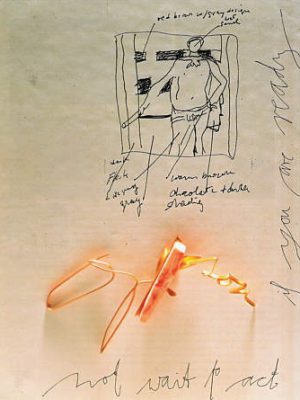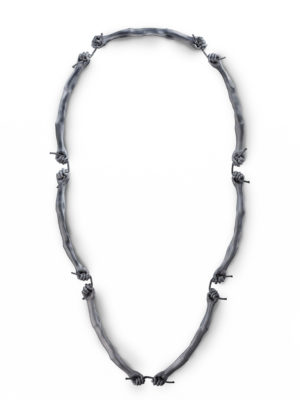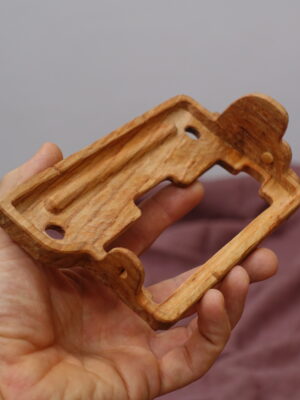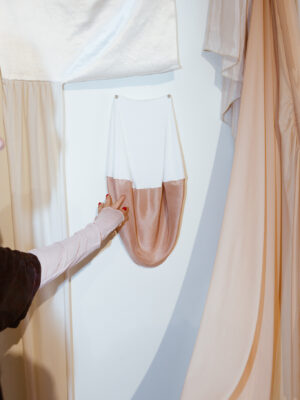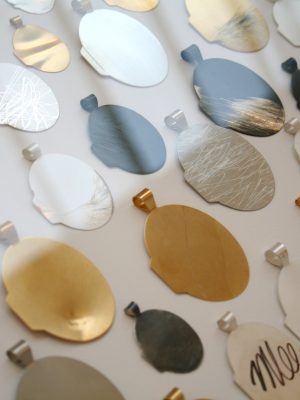CURRENT OBSESSION:
What is jewellery?
Manfred Bischoff:
I must say it in German: ‘Kunst ist eine behauptung’.* That means I stand for it. Totally. The other thing is that I claim what jewellery is. And the third thing is – I must over-live jewellery. ‘Behauptung’ means staying behind what is jewellery and over-living it. If I stay with what I’m doing, I must take all the consequences. So the question is not what is jewellery. This question is not important. I think it’s important to use no adjectives. It’s a ‘behauptung’. I say this is jewellery and I stay behind it. Even if it’s stupid. But it is a controlled stupidity.
C.O.:
What is controlled stupidity?
M.B.:
If you are stupid, you are probably not inside the field. But I control my stupidity. The work is a work of a fool, but a controlled fool. I know what I’m doing; I know what is behind the work. The other thing is – I’m not interested in other worlds (ex. fine arts). If someone follows me in this world, and says: I accept this as jewellery then it’s OK. A famous philosopher said, ‘Art for me is what I declare as art’. It is a little bit like me. Jewellery for me is what I declare jewellery. I cannot influence others to agree. So I must concentrate my highest knowing, concepts I developed throughout my life… and do nothing! Do nothing. That’s the result. (laughing) I’m not interested in doing important things. For me the most important thing is to do nothing. So things disappear…
C.O.:
Is it about ‘1 + 6 + 7 – 14 = 0 ‘?**
M.B.:
Exactly! But I use the material that has no concurrence, maybe only by Tutankhamen!
C.O..:
Talking about materiality, you once said that the use of cheap materials in the beginning of your career for you meant rehearsal, the try-out before finding and developing your own language.
M.B.:
There is a bad word for jewellery. It’s called decoration. It was high decoration. It was close to other fields, like art, philosophy, literature, but it was too much wanted.
C.O.:
So gold gave you freedom?
M.B.:
Yes. I cannot live from steel pieces. Gold is an adequate material for my thinking. That’s all. Everyone who is creative should search for his adequate material. And in my case it’s gold. And it’s not even about it being gold. It is high precious gold. That means all the shit you see in the world that is called gold is 18K. The dealers of the jewellery industry are making their money by calling it gold. Gold must be clear. But there is a sacrifice to be made. I cannot use pure gold, because I need certain kind of rigidness for being able to work with it. So I have to come down to 22k gold. That is my sacrifice. Gold for me is much to do with the past, with older generations, and one should not make money form this.
C.O.:
So it is a pure substance. The purity you would not be able to achieve with any other material.
M.B.:
Yes. It is the only material that is ready for a change. The old human way to over-live is to begin this change. You cannot give a little bit of gold. You must give real gold; and then gold will be what it is. It never leaves you. If I have gold here I can immediately change it in another way. I don’t have to do anything to clean it and etc. It’s like clear water. In this way gold ‘goldens’. My titles can be cheap, but I ‘golden’ them. And I can get very very foolish, again, controlled foolish, by doing it in gold.
C.O.:
And what role the coral plays in your work?
M.B.:
I didn’t have a good life when I was young. And I often had wounds in my soul and in my body. And there is a famous sentence from Joseph Beuys, a title from a work: ‘Show your wound’*** and that is a little bit what it is about. I show my wound, I show that I was wounded in my life. And then I cover them with gold. But it is enough, if I see the depth, the whole story. The viewer must not look too deep, it is better to stay on the surface.
C.O.:
I wrote this in the train: ‘For me the work is poetry of high and low: effortlessness and fluency in art, philosophy and cheap porn’.
M.B.:
One can say this, yes.
C.O.:
The material in this case ties all these things together: weird sexual thoughts, funny, stupid, ridiculous, along with highly philosophical. I think titles play also really important role here?
M.B.:
It has no sense to name a piece by what is already there, what you can see. It has to be something else. But what is it?
C.O.:
Exactly! Is it to mislead the viewer, to help or to confuse him?
M.B.:
I think it’s better to confuse him. It should look to him as if it would help. So what he reads is not what he reads… But I’m not tricking him, not leaving him alone. I have experienced that people who bought my pieces had their own private names for them. So they stopped using my title. And I allow this. It’s fine. The work is no longer my responsibility.
C.O.:
Lets talk about presenting work for public viewing. The work always consists of three parts. First, there is a drawing, then, there is the actual jewellery piece, and finally, there is the title. What is your strategy here concerning the viewer?
M.B.:
The viewer shall not find the ‘hole’. He always wants the way out. But it is very foolish to find the ‘hole’. And by ‘hole’ I mean a solution, a certain kind of solution. Everyone is finding their own solutions, and its OK. The solution should seem easy. There are no adjectives. It is what you see.
C.O.:
How much a jewellery piece can handle? How much personal weight, how much political or social weight and does it need all that?
M.B.:
One can force with language. You can force any kind of substantive under certain circumstances. But I’m not interested in these kinds of things. I’m able to change meaning inside a piece. If I look at daily political debates on television I see how wrongly they use the language, and nobody says anything about it. So I am very careful in using important titles. Titles which look important. Never in history the language was used as badly as nowadays. So I try to use simple things. But simple things are not coming from thin air. If I read a newspaper or a book I find exactly the word I need; and I immediately have the result. In reality. In the making. There are a lot of things I’m collecting, pictures, cutouts from books, newspapers, posters; this is my database, my blueprint.
There are a lot of secrets in here, about where things are coming from and so on. Some of these stories are silly looking, but for me they mean something more. Things fall together, come down to one point for me. I’m not searching; I’m just reading newspapers. That’s all. I see wrong sentences and that is what I’m interested in. I see how people derogate words that are really important. I try to protect these words and give them a new frame in gold. Every case is different from another, it is not systematic, it’s inner. I’m reading one day and: ‘Oh, Jesus, now I have it!’
I want to tell you a story. There is this guy who went to the house of Junger. House built of mirrors. He found a document, a medical prescription for an old medicine that says: ‘simmer jünger’ (always younger), so Junger was using the medicine that was called Always Younger. These are the things I’m interested in. When reality collides with stupidity, some kind of absurd. This point of collision is my place, my realm.
C.O.:
Do not wait to act…If you are ready?****
M.B.:
During my artist residency at Isabella Stewart Gardner Museum in Boston they told me to search for a piece from their collection and make a reference to it. So I went to the Museum and there was the Hercules of Piero Della Francesca, and I decided to use it because it was not a real Hercules, but more of a slimy boy. It was a fresco, which they took from the wall of Della Francesca’s house. On the backside of the fresco he wrote, ‘Do not wait to act…If you are ready’. But in the museum you cannot see it anymore, I found the evidence of it in the restorer’s reports and it is very important. This pre-explosive waiting before the action – it has no sense to do something without a key. Sometimes to begin a process, to search for solutions, try things out and then say, if one can use it or not. But as I said before, I’m not using adjectives. I’m saying: ‘I make this if I’m ready,’ Then – I do it. Waiting for this explosive moment is important. But you must be prepared and then act immediately. Not waiting until tomorrow – act immediately. For me it became a very important sentence. But the question follows is when are you ready? It is a question for oneself; it is not coming form the outside. Question Am I Ready? I think one must come to a certain inner confusion. Then either I hold this confusion or I try and solve it. So the confusion for me is the sign of readiness, because one must find the way out – to regulate it. Either you write it down, or you sing a song etc. It is called supplementation*****
C.O.:
The driving force in your work is Eros, what is it for you exactly?
M.B.:
Eros is not sex. Sex can be a final solution. Eros is a never-ending junkie journey of the visible. If someone takes away the images of the world I think I would die. That’s the end. I am totally not interested in fake images, but there comes my aesthetic choice that I allow my eyes to only see the best. There is also a decision to push other things away. So I keep only interesting images in my head, all the others have no place. Images create Self; I’m not creating images. They are my hope. And it is a never-ending story. Someone says: ‘I found a solution!’ How stupid, I never found a solution! I have my own aesthetic and within this aesthetic there lays value. I can tell that my aesthetic is widely spread, that means I saw a lot of things. So one cannot say to me that I saw nothing, that I read only one newspaper. It is a matter of age. I am not anymore so easily influenced. But it does not mean that I’m strong. It just means that at a certain point I realized I spent so much time doing something, what else shall I do? I often think about this. OK, I can be a good cook, but starting now… I don’t know. What I like about living here in Florence, is that the way things are has a lot to do with my thinking and my work: there is a terrible restaurant, somebody opens it and the food is not good, but its food. I like this very much. I think that’s the world. Other things are not important. I think in Munich you cannot eat in any place as cheap and as good as at San Frediano (District of Florence). These are the solutions for the world, not the high and polished…
C.O.:
When I was in my second year of Alchimia, I didn’t know if I should continue to the third year. So I asked teachers if I could be present on one of your lectures. It was towards the end of the year, so people were showing quite developed work. You were giving critique to one of the third year students – Gerri Nishi – she made this cement block. To demonstrate your position, you simply picked up this block, put a pair of scissors under it, and then just took another student’s work and put it in the same line. After a long pause, you said: ‘You see?’ And I thought I really saw! Something you cannot really describe with words, but it was there!
M.B.:
It works. It was an example for complex view, not certain view. Things can work and have a big aesthetic even if they don’t belong together: they have no sense – that’s how it works. They are beautiful look at it! So to take away this concentration on the spot, like on the stage – that is what I always do. The most important thing is to describe the difference. If I have another example, I can tell which one has higher quality, so I can conclude the direction to continue with. And that is my way of teaching and my way of thinking.
C.O.:
So it is not about what they say individually, but more about what they say as a sequence?
M.B.:
I can see things immediately complex: the complexity of a whole.
C.O.:
For me it is also about how you taught us small things: that the line shall never be even, it must be nervous and sketchy, like a pencil drawing, even if its made of metal.
M.B.:
I have a strange thinking, which is not common; it all comes from my personal story and experiences I’ve been through. What I tell students, as a teacher is always a result of what they show me. I can immediately react on it, I have a lot of ways of entering the situation (someone’s work); my reaction never comes from one place. I must be very quick in my reaction, because I should not think too much. So sometimes I also said stupid, wrong, rude things, but as long as the reaction is immediate, even with these wrong notions, I get closer to the source. It is always important for me as a teacher, to come from the outside, not too close to the work or the persons. The other thing is a will to make a difference – to say: ‘This is better then this.’ I cannot say if something is good, if I have nothing next to it.
C.O.:
It was always about groups of pieces, try-outs on the table, where you were re-grouping things, putting stuff away. One cannot judge from a single piece, because it does not say anything.
M.B.:
At the very end – one piece or two…that is very successful.
C.O..:
It’s this constant peeling, like a cabbage… I remember in the book ‘Üb ersetzen’ you said; ‘If I had to reduce everything, I would say that that’s what it’s all about. Breathing in and breathing out, the entrance and the exit.’
M.B.:
It also comes from my story. I had a serious depression in the past, and when I asked my psychiatrist: ‘where is the exit’, he immediately replied – ‘at the entrance’. Ever since I never had problems with finding the exit. It’s very clear, very easy. You always find the exit at the entrance. You must not search for the exit; you will always find it at the entrance. The question and the answer are both very precise. For me it’s a very deep experience and if I would have to name an accumulation of thoughts, I would say this is the most important sentence in my life.
* Translates from German language as: ‘Art is a claim’
** Quoted from the book ‘Üb ersetzen’, 1993: ‘No matter how important the image or text, the synthesis of those elements always leads to nothing. 1 + 6 + 7 – 14 = 0. The works simply dissolve.’
*** ‘Show Your Wound’ was an installation created by Beuys in 1974-75 in a bleak pedestrian underpass in Munich. Elements used there can be seen in these negatives; a pair of dissecting tables and the heads of two iron agricultural tools, mounted on wooden sticks.
**** While his residency in 2002 at Isabella Steward Gardner Museum Bischoff was asked to react to one of the pieces in the collection. He chose a fresco by Piero Della Francesca. The result was the brooch titled Or-Son.
*****Something added to complete a thing, make up for a deficiency, or extend or strengthen the whole.
